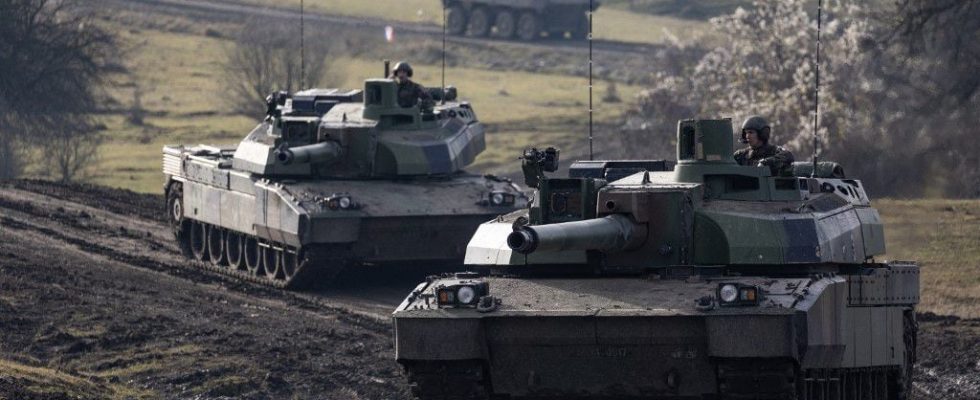What if NATO was no longer “brain dead” as Emmanuel Macron judged? Some 90,000 NATO soldiers will participate for several months starting next week in the largest military exercise organized by the Atlantic Alliance since the Cold War, against the backdrop of the conflict in Ukraine. “This will be a clear demonstration of our unity, our strength and our determination to protect each other,” declared Thursday, January 18, the Supreme Allied Commander in Europe (Saceur), American General Christopher Cavoli , during a press conference in Brussels, where NATO is headquartered.
These maneuvers, which will extend over several months from the Atlantic to the eastern flank of NATO, will take the form of a conflict scenario against an “adversary of comparable size”, according to the terminology of the Alliance, which designates thus, without naming it, Russia, whose large-scale offensive in Ukraine began almost two years ago. They will notably include the reinforcement on the European continent of troops “from North America”, said General Cavoli. Some 50 warships, 80 aircraft and 1,100 combat vehicles will take part in this largest “war game” since the 1988 “Reforger” exercise, in the midst of the Cold War between the Soviet Union and the Atlantic Alliance.
“This is a record in terms of the number of soldiers,” said Dutch Admiral Rob Bauer, head of the NATO military committee, which brings together heads of state, during the same press conference. major of the armies of the 31 member countries of the organization. On Wednesday January 17, he declared that “we must prepare for all eventualities”, because we are “in an era where anything can happen at any time”, adding that “the tectonic plates of power are shifting”.
20,000 soldiers on the British side
The United Kingdom alone will deploy 20,000 soldiers as part of these maneuvers, its Defense Minister Grant Shapps announced on Monday. This deployment, which he described as “the most important” in forty years for British forces within NATO, aims to respond to the “threat” posed by President Vladimir Putin’s Russia since the invasion of Ukraine. Very invested in this diplomatic issue, the United Kingdom called, on Monday January 15, on European NATO countries to increase their defense budget to 2.5% of GDP.
Units from the Royal Air Force, the Royal Navy and the Army will be sent across Europe and beyond for this exercise called “Steadfast Defender”, London explained. Grant Shapps said NATO faced “greater than ever” challenges from Russia, China, Iran and North Korea, warning that the Alliance’s adversaries were “more connected to each other” than ever.
On the ground in Ukraine, Russian ground troops suffered very severe damage, said Dutch Admiral Rob Bauer, noting, however, that the Russian navy and air force remained “considerable” forces. “Intense fighting” is still taking place but, “although the Russian attacks are devastating, they are not significant from a military point of view,” he said. Last year, the world was perhaps a little too optimistic and it is therefore “important that in 2024 we are not too pessimistic”, said this senior Alliance official.
kyiv demands more resources
The front line between the Russian and Ukrainian armies has barely moved in recent months and kyiv is insistently demanding additional weapons and ammunition if it hopes to achieve a significant military breakthrough. Ukraine in particular is asking for more anti-aircraft defense means, at a time when its infrastructure and cities are being shelled every day. But American military aid of more than 60 billion dollars is still blocked in Congress due to the reluctance of Republican elected officials and a European financial contribution over four years of 50 billion euros meets the same fate due to a veto of Hungary. A solution could nevertheless be found at the summit of the Twenty-Seven on February 1 in Brussels.
Since the start of the Russian assault in Ukraine in February 2022, the Atlantic Alliance has strengthened its defenses on the eastern flank, sending thousands of men there. NATO is trying to send a message of dissuasion “to convince the Kremlin that its crazy adventure in Ukraine will cost it dear; that its attempt to weaken NATO and the EU is having the opposite effect; and that its hope long term to see Westerners get tired of war is vain”, remarked last June in L’Express Rym Momtaz, of the International Institute for Strategic Studies.
For their part, the Baltic States see NATO as the only way to protect them, but also Ukraine. “Its membership in NATO is its best guarantee of security”, according to the liberal newspaper The Economist. NATO has positioned multinational battalions in the Baltic States to slow the progress of any aggressor in the event of an invasion. For the moment, Russia has not yet dared to touch the Alliance, more awake than ever since the war in Ukraine.
